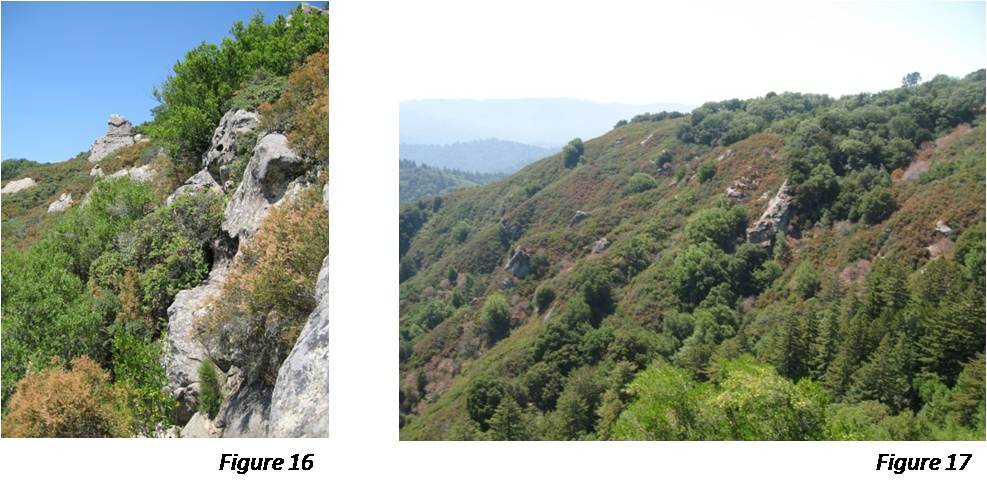This is the fourth and final post in a series about Castle Rock State Park, submitted by a reader named Jonathan. In the first post, Jonathan explained why he chose to write about Castle Rock State Park and he also showed where it’s located. In the second post, Jonathan discussed the geologic history of the park. In the third post, Jonathan discussed Castle Rock and surrounding outcroppings. In this fourth and final post on Castle Rock State Park, Jonathan discusses the Falls Overlook, outcroppings along Saratoga Gap Trail and Ridge Trail, and Goat Rock. Jonathan also makes some concluding remarks.
Figure 15
Approximately 1 mile from the Park’s main entrance is Castle Rock Falls and the Falls Overlook (figure 15). According to the Park’s brochure, this formation is roughly 100 feet tall. This sheer wall of Vaqueros Sandstone is somewhat of an anomaly because it doesn’t contain any of the pockmarks of tafoni found on most other formations. Since the formation is located in the Kings Creek Canyon, perhaps it is better protected from dry winds that might otherwise wick absorbed water to the rocks’ surface and bring with it the dissolved carbonic acid and calcium carbonate.
Along the roughly 2 mile stretch of the Saratoga Gap Trail, between Castle Rock Falls and Russell Point, there are multiple outcroppings that tower over the San Lorenzo Valley (figures 16 and 17).
Figure 18
Many of the formations along the Saratoga Gap Trail resemble the outcroppings near Castle Rock with boulder-like shapes covered with tafoni (figure 18).
However, there was one spot where the outcropping was distinct. Unlike elsewhere in the Park where the Vaqueros Sandstone is uniform, in this spot the rock appeared layered (figure 19). Between the layers, there seemed to be differential erosion, indicating different make-ups of the rocks. Moreover, the layers appeared to dip, possibly due to the folding of the sedimentary strata is this particular area.
Figure 19
While the outcroppings along the roughly 2 mile stretch of the Ridge Trail were similar to others in the park, there was one that deserved additional attention given its resemblance to a human—or perhaps ogre—face (figure 20). Concretions formed his ears and nose, tafoni formed his eyes and nostrils, a joint formed his mouth, and lichen gave him hair.
Figure 20
With vertical drops and tafoni of varied sizes, Goat Rock (figure 21), at over 80 feet tall, provides local rock climbers with more than a dozen climbing routes. While formed of the same Vaqueros Sandstone found throughout the Park, Goat Rock’s surface is very hard, which is likely due to the calcium carbonate pulled towards the rock’s crust. Additionally, its massive size and location, perched on the mountain’s ridge, makes Goat Rock one of the most prominent features of the Park.
Conclusion:
Castle Rock State Park provides several models for illustrating geologic processes. The Park’s multiple Vaqueros Sandstone outcroppings represent the formation of submarine sedimentary rock and its subsequent uplifting to form part of the Santa Cruz Mountains. Moreover, the results of jointing and chemical, mechanical, and biological weathering are easy to spot, whether in the form of tafoni or concretions. Many of the same forces that shape the geology of the National Parks of the West are recognizable in our “backyard;†at Castle Rock.
Figure Sources and References:
Figure Sources
1. Figure 1 and 3: ExpertGPS Calibrated Maps – Castle Rock State Park
2. Figure 2: Google Maps
3. Figure 4: Corbella, L. “Submarine Canyons and Deep-sea Fans”
4. Figure 5: Stanley, RG., Evolution of the Tertiary La Honda Basin, Central California (1990), “Figure 12.
Distribution of the Vaqueros Sandstone and Zayante Sandstone in the La Honda basin.”
5. Figure 6: Graymer, R. W.; Moring, B. C.; Saucedo, G. J.; Wentworth, C. M.; Brabb, E. E.; and Knudsen, K. L., Scientific Investigations Map, Geologic map of the San Francisco Bay region (2006)
6. Figures 7-13, 15-21:
7. Figure 14: Castle Rock State Park Brochure, California State Parks and Portola and Castle Rock
Foundation (2004)
References
1. Stanley, R.G., 1990, Evolution of the Tertiary La Honda basin, central California, in Garrison, R.E., Greene,
H.G., Hicks, K.R., Weber, G.E., and Wright, T.L., eds., Geology and tectonics of the central California coast region, San Francisco to Monterey, volume and guidebook: Bakersfield, Pacific Section, American
Association of Petroleum Geologists, Book GB67, p. 1–29.
2. Allaby, A., Allaby, M., 1999, A Dictionary of Earth Sciences, Deep-sea Fans.
3. Stoffer, P, 2002, Rocks and Geology in the San Francisco Bay Region, U.S. Geological Survey Bulletin 2195.
4. Hogan, C.M, Patmore L., Crimp, D. et al., 1978, San Lorenzo Basin Groundwater Recharge and Water
Quality Study, Earth Metrics Incorporated, Association of Monterey Bay Area Governments.
5. Castle Rock State Park Website
6. California State Parks, Portola and Castle Rock Foundation, 2005, Castle Rock State (brochure).
7. California State Parks, Portola and Castle Rock Foundation, 2004, Castle Rock State Park Climbing Map.






